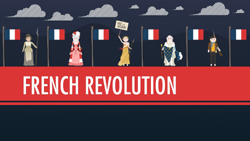| The British brought order and stability to India, but
India paid a high price for British rule. The mistrust and cultural differences
between the British and Indians sparked an independence movement and renewed
interest among Indians in their culture and history.
The Sepoy Mutiny
-
Mistrust and cultural differences between the British and
Indians led to violent conflict.
Over the course of the eighteenth century, British power
in India had increased while the power of the Mogul rulers had declined
(see Chapter 15). The British government gave a trading company, the British
East India Company, power to become actively involved in India’s political
and military affairs. To rule India, the British East India Company had
its own soldiers and forts. It also hired Indian soldiers, known as sepoys,
to protect the company’s interests in the region.
Events Leading to Revolt
In 1857 a growing Indian distrust of the British led
to a revolt. The British call the revolt the Sepoy Mutiny. Indians call
it the First War of Independence. Neutral observers label it the Great
Rebellion. The major immediate cause of the revolt was a rumor that the
troops’ new rifle cartridges were greased with cow and pig fat. The cow
was sacred to Hindus. The pig was taboo to Muslims. To load a rifle at
that time, soldiers had to bite off the end of the cartridge. To the sepoys,
touching these greased cartridges to their lips would mean that they were
polluted.
A group of sepoys at an army post in Meerut, near Delhi,
refused to load their rifles with the cartridges. The British charged them
with mutiny, publicly humiliated them, and put them in prison. This treatment
of their comrades enraged the sepoy troops in Meerut. They went on a rampage,
killing 50 European men, women, and children. Soon other Indians joined
the revolt, including Indian princes whose land the British had taken.
Within a year, however, Indian troops loyal to the British
and fresh British troops had crushed the rebellion. Although Indian troops
fought bravely and outnumbered the British by about 230,000 to 45,000,
they were not well organized. Rivalries between Hindus and Muslims kept
the Indians from working together.
Atrocities were terrible on both sides. At Kanpur
(Cawnpore), Indians massacred 200 defenseless women and children in a building
known as the House of the Ladies. Recapturing Kanpur, the British took
their revenge before executing the Indians.
Effects of the Revolt
As a result of the uprising, the British Parliament transferred
the powers of the East India Company directly to the British government.
In 1876 Queen Victoria took the title Empress of India.
The people of India were now her colonial subjects, and India became her
“Jewel in the Crown.”
Although the rebellion failed, it helped to fuel Indian
nationalism. The rebellion marked the first significant attempt by the
people of South Asia to throw off British Raj (rule). Later, a new
generation of Indian leaders would take up the cause.
What were some effects of the
Great Rebellion?
REVIEW & DO
NOW
Answer the following questions in your spiral notebooks: |
| . |
. |
|
|
British Colonial Rule
-
The British brought order and stability to India, but they
also hurt India’s economy and degraded the Indian people.
After the Sepoy Mutiny, the British government began to rule
India directly. They appointed a British official known as a viceroy
(a governor who ruled as a representative of a monarch). A British civil
service staff assisted the viceroy. This staff of about 3,500 officials
ruled almost 300 million people, the largest colonial population in the
world. British rule involved both benefits and costs for Indians.
Benefits of British Rule
British rule in India had several benefits for subjects.
It brought order and stability to a society badly divided into many states
with different political systems. It also led to a fairly honest, efficient
government. Through the efforts of the British administrator and historian
Lord Thomas Macaulay, a new school system was set up. The new system used
the English language, as Macaulay explained:
“What then shall the language of education be?
[Some] maintain that it should be the English. The other half strongly
recommend the Arabic and Sanskrit. The whole question seems to me to be,
which language is the best worth knowing? . . . It is, I believe, no exaggeration
to say that all the historical information which has been collected from
all the books written in the Sanskrit language is less valuable than what
may be found in short textbooks used at preparatory schools in England.”
—A New History of India, Stanley
Wolpert, 1977
The goal of the new school system was to train Indian
children to serve in the government and army. The new system served only
elite, upper-class Indians, however. Ninety percent of the population remained
uneducated and illiterate.
Railroads, the telegraph, and a postal service were introduced
to India shortly after they appeared in Great Britain. In 1853 the first
trial run of a passenger train traveled the short distance from Bombay
to Thane. By 1900, 25,000 miles (40,225 km) of railroads crisscrossed India.
Costs of British Rule
The Indian people, however, paid a high price for the
peace and stability brought by British rule. Perhaps the greatest cost
was economic. British entrepreneurs and a small number of Indians reaped
financial benefits from British rule, but it brought hardship to millions
of others in both the cities and the countryside. British manufactured
goods destroyed local industries. British textiles put thousands of women
out of work and severely damaged the Indian textile industry.
In rural areas, the British sent the zamindars to collect
taxes. The British believed that using these local officials would make
it easier to collect taxes from the peasants. However, the zamindars in
India took advantage of their new authority. They increased taxes and forced
the less fortunate peasants to become tenants or lose their land entirely.
Peasant unrest grew.
The British also encouraged many farmersto switch from
growing food to growing cotton. As a result, food supplies could not keep
up with the growing population. Between 1800 and 1900, 30 million Indians
died of starvation.
Finally, British rule was degrading, even for the newly
educated upper classes who benefited the most from it. The best jobs and
the best housing were reserved for Britons. Although many British colonial
officials sincerely tried to improve the lot of the people in India, British
arrogance cut deeply into the pride of many Indians.
The British also showed disrespect for India’s cultural
heritage. The Taj Mahal, for example, was built as a tomb for the beloved
wife of an Indian ruler. The British used it as a favorite site for weddings
and parties. Many partygoers even brought hammers to chip off pieces as
souvenirs. British racial attitudes led to the rise of an Indian nationalist
movement.
How was British rule degrading
to Indians?
REVIEW & DO
NOW
Answer the following questions in your spiral notebooks: |
| . |
. |
|
|
Indian Nationalists
-
The British presence in India led to an Indian independence
movement.
The first Indian nationalists were upperclass and English-educated.
Many of them were from urban areas, such as Bombay (Mumbai),
Madras (Chennai), and Calcutta (Kolkata). Some were trained in British
law and were members of the civil service.
At first, many Indian nationalists preferred reform to
revolution. However, the slow pace of reform convinced many that relying
on British goodwill was futile. In 1885 a small group of Indians met in
Bombay to form the Indian National Congress (INC). The INC
did not demand immediate independence. Instead, it called for a share in
the governing process.
The INC had difficulties because of religious differences.
The INC sought independence
for all Indians, regardless of class or religious background.
However, many of its leaders were Hindu and reflected Hindu concerns. Later,
Muslims called for the creation of a separate Muslim League. Such a league
would represent the interests of the millions of Muslims in Indian society.
In 1915 the return of a young Hindu from South Africa
brought new life to India’s struggle for independence. Mohandas Gandhi
was born in 1869 in Gujarat, in western India. He studied in London and
became a lawyer. In 1893 he went to South Africa to work in a law firm
serving Indian workers there. He soon learned of the racial exploitation
of Indians living in South Africa.
On his return to India, Gandhi became active in the independence
movement. Using his experience in South Africa, he began a movement based
on nonviolent resistance. Its aim was to force the British to improve the
lot of the poor and to grant independence to India. Ultimately, Gandhi’s
movement led to Indian independence.
Who were the first Indian nationalists?
REVIEW & DO
NOW
Answer the following questions in your spiral notebooks: |
| . |
. |
|
|
Colonial Indian Culture
-
British rule sparked renewed interest among Indians in their
own culture and history.
The love-hate tension in India that arose from British domination
led to a cultural awakening as well. The cultural revival began in the
early nineteenth century with the creation of a British college in Calcutta.
A local publishing house was opened. It issued textbooks on a variety of
subjects, including the sciences, Sanskrit, and Western literature. The
publisher also printed grammars and dictionaries in various Indian languages.
This revival soon spread to other regions of India. It
led to a search for a new national identity and a modern literary expression.
Indian novelists and poets began writing historical romances and epics.
Some wrote in English, but most were uncomfortable with a borrowed colonial
language. They preferred to use their own regional tongues.
Nationalist Newspapers
Printed in the various regional Indian languages, newspapers
were a common medium used to arouse mass support for nationalist causes.
These newspapers reached the lower-middle-class populations—tens of thousands
of Indians who had never learned a word of English.
In his newspaper Kesari (“The Lion”), journalist
Balwantrao Gangadhar Tilak used innuendo (suggestion) to convey the negative
feelings about the British without ever writing anything disloyal. G. S.
Aiyar, editor of the popular Swadeshamitram (“Friend of Our Own
Nation”), organized the Triplicane Literary Society. At these meetings,
the region’s young intellectuals gathered to discuss poetry and politics.
Tagore
The most famous Indian author was Rabindranath
Tagore, winner of the Nobel Prize in Literature in 1913. A great
writer and poet, Tagore had many talents. He was also a social reformer,
spiritual leader, educator, philosopher, singer, painter, and international
spokesperson for the moral concerns of his age. He set to music the Bengali
poem Bande Mataram (“Hail to Thee, Mother”), which became Indian
nationalism’s first anthem. Tagore liked to invite the great thinkers of
the time to his expansive country home, or estate. There he set up a school
that became an international university.
Tagore’s life mission was to promote pride in a national
Indian consciousness in the face of British domination. He wrote a widely
read novel in which he portrayed the lovehate relationship of India toward
its colonial mentor. The novel reflected an Indian people who admired and
imitated the British but who agonized over how to establish their own identity.
Tagore, however, was more than an Indian nationalist.
His life’s work was one long prayer for human dignity, world peace, and
the mutual understanding and union of East and West. As he once said,
“It is my conviction that my countrymen will
truly gain their India by fighting against the education that teaches them
that a country is greater than the ideals of humanity.”
—Rabindranath Tagore
How did the nationalist movement
parallel cultural developments in India?
REVIEW & DO
NOW
Answer the following questions in your spiral notebooks: |
| . |
. |
|
|
|





